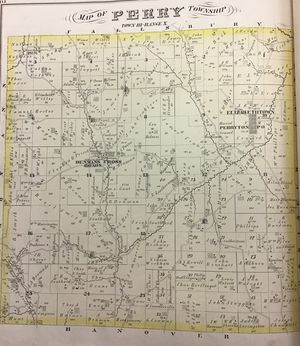Perry Township
Early European Settlement
The first European settler of the township was Samuel Hickerson, who built a cabin near the Brushy Fork in 1810. A steady stream of new arrivals followed until the township was organized. Named in honor of Commodore Perry, the district was a part of Hanover Township until being divided into its own district in 1818. [1]
Communities
Elizabethtown, known today as Perryton, is Perry Township's only settlement of note. It was founded in 1829 or 1831, by Elizabeth Lemert, who gave the settlement its name, and several of her children. [2] In 1866, the community had a school, two blacksmiths, two doctors, a grocery, and a cabinet maker that doubled as a notary public. [3] Elizabethtown had a population over one hundred inhabitants in 1881. [4] The Perryton post office opened in 1836 and the village was rechristened as Perryton in 1883. The post office closed in 1905. [5]
Denman's Cross Roads was surveyed and plotted as a village, but never became a significant settlement. Phillip Denman was one of the earliest settlers in the area, constructing a house in 1813 that, at eighteen by twenty-eight feet, was the largest home in the township. By 1881, the community possessed no more than six families a store and a couple of shops. [6] The area seems to be the same that would become the post office village of Reform, or Cooksey. There remains a cluster of buildings at the cross roads (Mary Ann Furnace Road and Reform Road), including the Perry Township Office building. [7]
The township retains its rural character in the 21st century with a total population in the 2010 census of 1,603. [8]
J.G.
Return to Townships and Communities main page.
References
- ↑ Hill, N., History of Licking County, (1881), 584-585
- ↑ Hill, N., History of Licking County, (1881), 585
- ↑ Atlas of Licking County, ed. F. W. Beers (1866), 11
- ↑ Hill, N., History of Licking County, (1881), 585
- ↑ Ohio Ghost Towns: No 44 Licking County, ed. Helwig and Helwig, (1998), 68
- ↑ Hill, N., History of Licking County, (1881), 585
- ↑ Ohio Ghost Towns: No 44 Licking County, ed. Helwig and Helwig, (1998), 60, 64, 135
- ↑ https://lickingcounty.gov/civicax/filebank/blobdload.aspx?BlobID=49111
